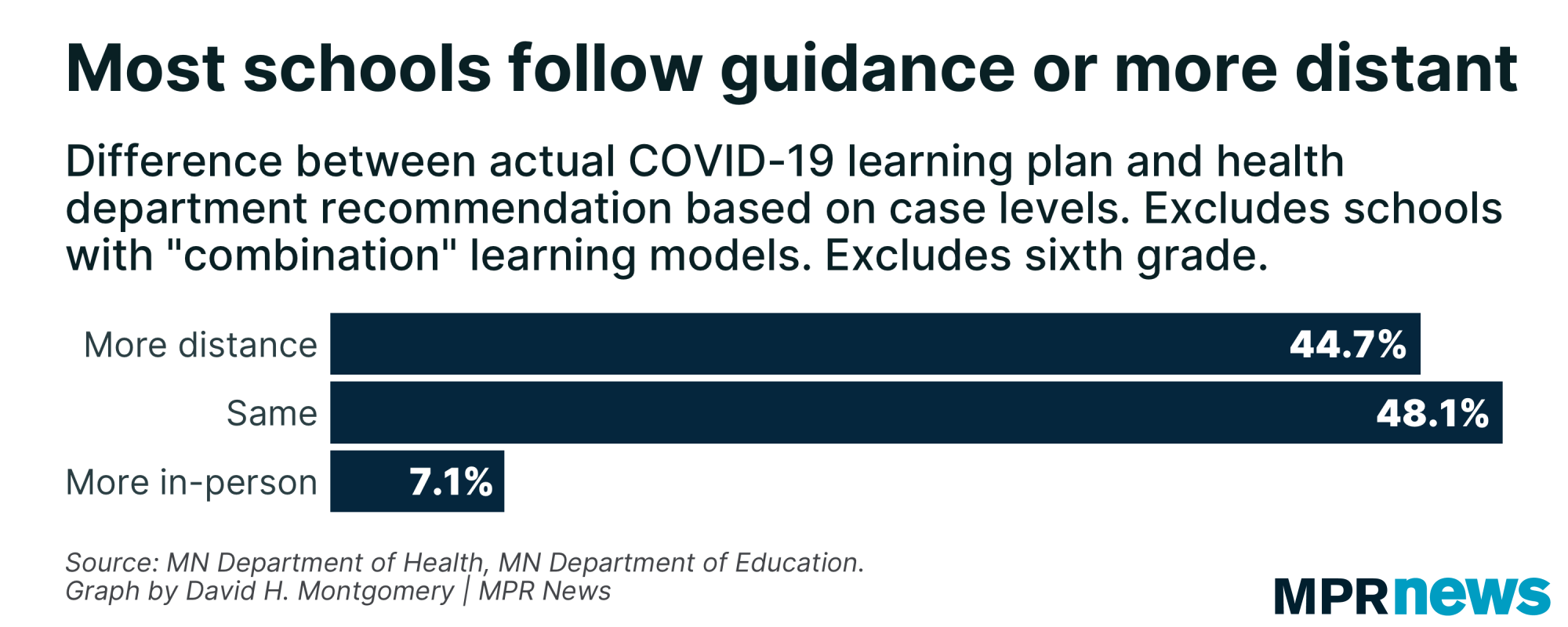COVID-19 cases already closing some Minnesota school buildings

Go Deeper.
Create an account or log in to save stories.
Like this?
Thanks for liking this story! We have added it to a list of your favorite stories.
Three weeks into the new academic year, COVID-19 cases are already causing some K-12 districts across Minnesota to close their school buildings and send teachers and students into quarantine.
More than 350 of the more than 2,000 schools across the state have already had an instance of at least one student or staff member contract the virus. In some instances, there have been multiple cases at those schools.
But in many cases, virus transmission is not taking place inside of school buildings.
“The number of new cases each day is now exceeding about 60 new cases each day out of the school community, which doesn’t necessarily mean — and often doesn’t mean — transmission at the schools,” said Health Commissioner Jan Malcolm.
Turn Up Your Support
MPR News helps you turn down the noise and build shared understanding. Turn up your support for this public resource and keep trusted journalism accessible to all.
In southern Minnesota, leaders of Fairmont Area Schools changed their learning scenario after new positive cases surfaced both inside the school buildings and in the wider community.
When a 10th grade student and high school history teacher tested positive for COVID-19, officials decided to quarantine the entire sophomore class.
Within days, they switched the whole high school to distance learning.
Superintendent Joseph Brown pointed to events elsewhere in the region that have caused county case rates to rise. Earlier this month, hundreds of people attended a funeral in Martin County without wearing masks or maintaining social distancing, according to health officials who say that event led to dozens of COVID-19 infections in the region.
Brown said the uptick in cases is now having an effect on students’ ability to gather in person in school buildings. Middle and high school students this week switched first to hybrid then to distance learning, and elementary students will begin attending school in a hybrid model starting next week.
“I’m disappointed in our region. And I’m really sad,” Brown said. “I’m kind of angry because this is not our kids’ fault. You know that the adults are not doing what they need to do.”
He said he knows of at least six weddings that are currently scheduled for the upcoming weekend in the area.
Martin County is not the only part of the state to be affected by virus spread outside of school buildings.
In Brainerd this week, district officials canceled high school classes and then transitioned all students in ninth through 12th grade to full-time distance learning for two weeks.
Brainerd Superintendent Laine Larson said in a letter to district families that the district came to the decision after discovering a spreading cluster of COVID-19 infections among students.
“Our current cluster has grown to a point where we cannot contact trace each person involved within the positive cluster exposure,” Larson wrote. “It has become clear that the rapid transmission of these positive cases occurred outside of school during social gatherings.”
Temporary changes
On average, Bob Indihar, executive director of Minnesota Rural Education Association, said the first few weeks of school have gone as smoothly as people could expect.
But with a growing number of COVID-19 cases, community spread, staffing shortages and the approach of the traditional flu season, Indihar said many school leaders in greater Minnesota expect it’s a matter of when, not if, they will have to pivot to different learning models due to spread of the virus.
“The thoughts now are when will they have to change models,” Indihar said.
Districts are reacting quickly to change learning scenarios when virus cases rise, but most school officials are saying the changes are temporary for now.
In Sauk Rapids, district leaders had planned to start in-person learning for elementary students this week. Instead, they temporarily closed one of their elementary schools and moved those students to distance learning after a COVID-19 case affected at least one person at Pleasantview Elementary.
In a letter to district families, officials said the change was temporary.
“District officials feel it is in the best interest of students, staff and the community to close the building to in-person learning for two weeks in order to contain the spread of COVID-19,” officials wrote, adding that they would make a decision about which model they would choose going forward in the beginning of October.
What the numbers show
New data from the Minnesota Department of Education shows consistent regional trends in regards to what learning scenarios schools are choosing for their students.

The most popular learning scenario at the moment is hybrid learning, in which students take turns coming to school to keep buildings from getting too crowded. About half of the students in the state are attending school under this blended approach. The next most popular scenario is distance learning.
Distance learning is happening more in metro-area and suburban schools. And in-person or hybrid learning is more likely to be the scenario of choice in greater Minnesota.

A formula produced by the Health Department generates guidance for districts to help decide whether to have in-person learning, distance learning, or a mix, based on the rate of COVID-19 cases in that district’s county over a two-week period.
Most Minnesota schools are either adhering to the learning model recommended by their county case numbers or they’re being more conservative than what the county models would allow.

MPR News reporters Hannah Yang, Kirsti Marohn and David H. Montgomery contributed to this story.


